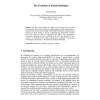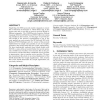BCSHCI
2007
15 years 2 months ago
2007
The use of formal models for user interface design can provide a number of benefits. It can help to ensure consistency across designs for multiple platforms, prove properties such...
ECTEL
2008
Springer
15 years 2 months ago
2008
Springer
The idea of representing knowledge in formal models gets more and more popular. Since these models are understandable and thus processable by machines, the retrieval of knowledge i...
108
Voted
CCS
2008
ACM
15 years 2 months ago
2008
ACM
Single-Sign-On (SSO) protocols enable companies to establish a federated environment in which clients sign in the system once and yet are able to access to services offered by dif...
116
click to vote
ASM
2010
ASM
15 years 4 months ago
2010
ASM
The B method is one of the most used formal methods, when reactive systems is under question, due to good support for refinement. However, obtaining the formal model from requireme...
107
click to vote
ISORC
2000
IEEE
15 years 4 months ago
2000
IEEE
The Unified Modeling Language UML is well-suited for the design of real-time systems. In particular, the design of dynamic system behaviors is supported by interaction diagrams an...
106
Voted
ACSD
2001
IEEE
15 years 4 months ago
2001
IEEE
We describe a framework where formal models can be rigorously defined and compared, and their interconnections can be unambiguously specified. We use trace algebra and trace struc...
ERSHOV
2006
Springer
15 years 4 months ago
2006
Springer
Abstract. Two formal models for description of timing attacks are presented, studied and compared with other security concepts. The models are based on a timed process algebra and ...
130
click to vote
IWPC
1996
IEEE
15 years 4 months ago
1996
IEEE
Mastering the complexity of programs and systems, particularly distributed systems, should lead to signi cant improvements in program and system understanding. In this paper we pr...
99
Voted
FSTTCS
1999
Springer
15 years 4 months ago
1999
Springer
Abstract. Hybrid knowledge bases (HKB’s) [11] were developed to provide formal models for the mediation of data and knowledge bases [14,15]. They are based on Generalized Annotat...
FM
1999
Springer
15 years 4 months ago
1999
Springer
Software architecture addresses the high level specification, design and analysis of software systems. Formal models can provide essential underpinning for architectural descripti...





